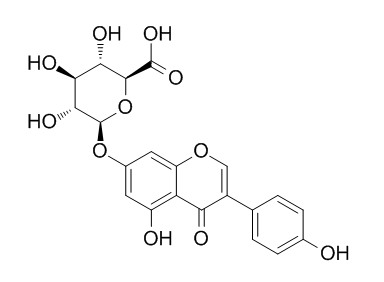Genistein 7-O-glucuronide
Genistein 7-O-glucuronide has estrogenic potency.
Inquire / Order:
manager@chemfaces.com
Technical Inquiries:
service@chemfaces.com
Tel:
+86-27-84237783
Fax:
+86-27-84254680
Address:
1 Building, No. 83, CheCheng Rd., Wuhan Economic and Technological Development Zone, Wuhan, Hubei 430056, PRC
Providing storage is as stated on the product vial and the vial is kept tightly sealed, the product can be stored for up to
24 months(2-8C).
Wherever possible, you should prepare and use solutions on the same day. However, if you need to make up stock solutions in advance, we recommend that you store the solution as aliquots in tightly sealed vials at -20C. Generally, these will be useable for up to two weeks. Before use, and prior to opening the vial we recommend that you allow your product to equilibrate to room temperature for at least 1 hour.
Need more advice on solubility, usage and handling? Please email to: service@chemfaces.com
The packaging of the product may have turned upside down during transportation, resulting in the natural compounds adhering to the neck or cap of the vial. take the vial out of its packaging and gently shake to let the compounds fall to the bottom of the vial. for liquid products, centrifuge at 200-500 RPM to gather the liquid at the bottom of the vial. try to avoid loss or contamination during handling.
Toxicol In Vitro.2019, 59:161-178
Int J Mol Sci.2022, 23(23):15213.
Antioxidants (Basel).2020, 9(2): E119
Proc. Sci. Math.2024, V25:108-123
Int. J. Mol. Sci.2022, 23(8), 4130.
Inflammation.2021, doi: 10.1007
Molecules. 2013, 18(11):14105-21
J Am Soc Mass Spectrom.2021, 32(5):1205-1214.
Int J Mol Sci.2022, 23(5):2796.
Antioxidants (Basel).2020, 9(6):466.
Related and Featured Products
Toxicology in Vitro, 2015,29(4):706-715.
Deconjugation of soy isoflavone glucuronides needed for estrogenic activity.[Reference:
WebLink]
Soy isoflavones (SIF) are present in the systemic circulation as conjugated forms of which the estrogenic potency is not yet clear.
METHODS AND RESULTS:
The present study provides evidence that the major SIF glucuronide metabolites in blood, genistein-7-O-glucuronide (GG) and Genistein 7-O-glucuronide (DG), only become estrogenic after deconjugation. The estrogenic potencies of genistein (Ge), daidzein (Da), GG and DG were determined using stably transfected U2OS-ERα, U2OS-ERβ reporter gene cells and proliferation was tested in T47D-ERβ cells mimicking the ERα/ERβ ratio of healthy breast cells and inT47D breast cancer cells. In all assays applied, the estrogenic potency of the aglycones was significantly higher than that of their corresponding glucuronides. UPLC analysis revealed that in U2OS and T47D cells, 0.2–1.6% of the glucuronides were deconjugated to their corresponding aglycones. The resulting aglycone concentrations can account for the estrogenicity observed upon glucuronide exposure. Interestingly, under similar experimental conditions, rat breast tissue S9 fraction was about 30 times more potent in deconjugating these glucuronides than human breast tissue S9 fraction.
CONCLUSIONS:
Our study confirms that SIF glucuronides are not estrogenic as such, and that the small % of deconjugation in the cell is enough to explain the slight bioactivity observed for the SIF-glucuronides. Species differences in deconjugation capacity should be taken into account when basing risk–benefit assessment of these SIF for the human population on animal data.



